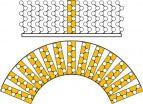(Press-News.org) Using a combination of high-powered computers and advanced experimental magnetic resonance data, a Florida State University biophysical chemist has developed techniques that improve the way scientists can study and predict the structure and dynamics of proteins found in the human body. His innovations could ultimately shorten the time it takes researchers to develop new, more effective drugs and better understand biomedical processes that underlie a variety of health conditions.
The new techniques "allow us to more accurately understand protein behavior and function at all levels, how enzymes work, and how to develop drugs that bind to certain proteins," said Rafael Brüschweiler, the George Matthew Edgar Professor in Florida State's Department of Chemistry and Biochemistry and associate director for biophysics at the National High Magnetic Field Laboratory.
Given that there are hundreds of thousands of different proteins found in the human body, innovations such as Brüschweiler's that can streamline their analysis and understanding are viewed as most desirable in the scientific community.
Over the past several years, Brüschweiler and his colleagues have integrated a pair of complementary but powerful tools, both of which provide detailed information about the structure and dynamics of proteins at the atomic level. Nuclear magnetic resonance (NMR) data are first collected for a particular protein that is being analyzed. (NMR is a research tool that utilizes high magnetic fields to measure the strengths, directions and temporary fluctuations of magnetic interactions between the atoms in a protein fragment.)
Next, in a technique Brüschweiler has pioneered, high-powered computers are used to validate the NMR data in terms of their realistic representation of protein structure and dynamics, as well as to make additional predictions of those characteristics.
The computational results critically rely on the shape of the protein's "energy landscape" — the conformational space available to that protein under physiological conditions. However, due to its complexity, improving characterizations of the energy landscape is a difficult and time-consuming undertaking. In fact, until recently, a computer simulation of a single protein that represented just a microsecond took several months. Now, with the aid of the powerful computer array at Florida State's High Performance Computing Center, it takes Brüschweiler and his group only a fraction of the time it once did.
Working with a postdoctoral associate, Da-Wei Li, Brüschweiler has found a highly efficient way to directly use the NMR information for improving the protein potential. The basic idea is to "recycle" an existing simulation of an intact protein, using methods borrowed from statistical physics, for many trial potentials until the one is found that yields the best agreement with experiment. This leads to an increase in speed by a factor of 100,000 or more over previous methods. The approach is not only efficient but also permits the improvement of the protein potential directly on intact proteins, rather than on small fragments, as was the case in the past.
"This has opened up a new way of becoming increasingly quantitative in our computations, which is key in developing a predictive understanding of the functions of proteins," Brüschweiler said.
"As computers continue to become ever more powerful, 'in silico' approaches to the understanding of proteins will play in increasingly important role. However, these approaches need to be calibrated first against quantitative experimental data, which makes the combination with NMR so powerful."
A paper describing the research was recently published in the German publication Angewandte Chemie (Applied Chemistry), one of the world's leading peer-reviewed chemistry journals. That paper, "NMR-Based Protein Potentials," is available here.
"This is the culmination of a number of years of research on our part, so obviously we're excited about the progress we have made," Brüschweiler said. "While this is fairly basic research designed to develop a greater understanding of life at a molecular level, it opens up a range of possibilities for future advances by scientists all over the world."
"For example, it might be possible to develop and refine new drugs that target specific proteins in a certain way," he said. "Or to design new proteins that act as 'molecular machines' to perform specific functions in response to chemical stimuli."
Brüschweiler is currently in the second year of a four-year, $608,782 grant from the National Science Foundation that is helping to fund his research.
INFORMATION:
Scientist develops new, innovative methods for characterizing proteins
2010-10-13
ELSE PRESS RELEASES FROM THIS DATE:
Hormone therapy after menopause might increase risk of kidney stones
2010-10-13
DALLAS – Oct. 11, 2010 – The use of estrogen therapy by postmenopausal women might increase the risk of developing kidney stones, according to findings by UT Southwestern Medical Center researchers.
In a study available online and in today's issue of the Archives of Internal Medicine, investigators found that estrogen therapy after menopause increased a woman's chances of developing kidney stones by approximately 20 percent. This discovery calls into question the long-held belief that estrogen might actually protect women from the disease, and clinicians need to keep ...
Diabetes hospitalizations rise dramatically for young women
2010-10-13
ANN ARBOR, Mich. – A study published in Journal of Women's Health shows a rapid increase in the number of hospitalizations due to diabetes for young adults – particularly young women.
Diabetes hospitalizations were up by 66 percent for all ages and sexes, but the number of diabetes hospitalizations among younger adults, ages 30-39, more than doubled from 1993 to 2006.
This pattern of hospitalizations echoes the dramatic increase in rates of obesity across the United States in the last 30 years, according to the study by the University of Michigan Health System.
Young ...
Listen up: Ocean acidification poses little threat to whales' hearing
2010-10-13
Contrary to some previous, highly publicized, reports, ocean acidification is not likely to worsen the hearing of whales and other animals, according to a Woods Hole Oceanographic Institution (WHOI) scientist who studies sound propagation in the ocean.
Tim Duda, of WHOI's Applied Ocean Physics & Engineering Department, undertook a study in response to warnings that as the ocean becomes more acidic—due to elevated levels of atmospheric carbon dioxide (CO2)--noise from ships will be able to travel farther and possibly interfere with whales and other animals that rely on ...
Scientists pinpoint gene linked to drug resistance in malaria
2010-10-13
Scientists have shed light on how malaria is able to resist treatment with a leading drug.
Researchers have identified a gene that enables the parasite that causes the infection to resist treatment with the plant-based remedy artemisinin.
In many countries where the parasite has developed resistance to previously effective common treatments such as chloroquine, artemisinin remains the only effective treatment against the infection. However, malarial resistance to artemisinin appears to be developing, potentially creating problems in controlling malaria.
Identification ...
Lack of antiepileptic drugs hurts awareness, treatment efforts in Zambia
2010-10-13
EAST LANSING, Mich. — Despite an international effort to raise awareness about epilepsy in resource-poor nations, a recently published study found nearly 50 percent of pharmacies in Zambia do not carry antiepileptic drugs, seriously hampering efforts to tackle one of the most cost-effective chronic conditions to treat.
The study, recently published in the American Journal of Tropical Medicine and Hygiene, was led by Gretchen Birbeck, an associate professor of neurology and ophthalmology and director for the International Neurologic & Psychiatric Epidemiology Program in ...
Nanoscopic particles resist full encapsulation, Sandia simulations show
2010-10-13
ALBUQUERQUE, N.M.— It may seem obvious that dunking relatively spherical objects in a sauce — blueberries in melted chocolate, say — will result in an array of completely encapsulated berries.
Relying on that concept, fabricators of spherical nanoparticles have similarly dunked their wares in protective coatings in the belief such encapsulations would prevent clumping and unwanted chemical interactions with solvents.
Unfortunately, reactions in the nanoworld are not logical extensions of the macroworld, Sandia National Laboratories researchers Matthew Lane and Gary ...
Young people with mental health problems at risk of falling through 'gap' in care services
2010-10-13
Many young people with mental health problems are at risk of falling through a huge gap in provision when they move from adolescent to adult care services, according to new research from the University of Warwick.
A team led by Professor Swaran Singh at Warwick Medical School looked at the transition from child mental health services to adult mental health services and found for the vast majority of users the move was "poorly planned, poorly executed and poorly experienced".
In a study published in The British Journal of Psychiatry, the research team looked at 154 service ...
Successful kidney transplantation despite tissue incompatibility
2010-10-13
Donor kidneys can be successfully transplanted even if there is strong tissue incompatibility between donor and recipient. An interdisciplinary working group headed by Dr. Christian Morath, senior consultant at the Department of Nephrology at Heidelberg University Hospital (Medical Director: Professor Dr. Martin Zeier) and Professor Dr. Caner Süsal, head of antibody laboratory in the Department of Transplantation Immunology, showed in a study of 34 sensitized high-risk patients that the success rate in these patients was not different from the success rate of patients with ...
Large study shows females are equal to males in math skills
2010-10-13
MADISON — The mathematical skills of boys and girls, as well as men and women, are substantially equal, according to a new examination of existing studies in the current online edition of journal Psychological Bulletin.
One portion of the new study looked systematically at 242 articles that assessed the math skills of 1,286,350 people, says chief author Janet Hyde, a professor of psychology and women's studies at the University of Wisconsin-Madison.
These studies, all published in English between 1990 and 2007, looked at people from grade school to college and beyond. ...
Study supports the long-term benefits of transcranial magnetic stimulation for depression
2010-10-13
(CHICAGO)–In a study to determine the durability and long-term effects of transcranial magnetic stimulation (TMS), psychiatric researchers at Rush University Medical Center have found the non-invasive, non-drug therapy to be an effective, long-term treatment for major depression. Results of the study were published in the October 2010 issue of Brain Stimulation, a journal published by Elsevier.
TMS therapy is a non-invasive technique that delivers highly focused magnetic field pulses to a specific portion of the brain, the left prefrontal cortex, in order to stimulate ...



